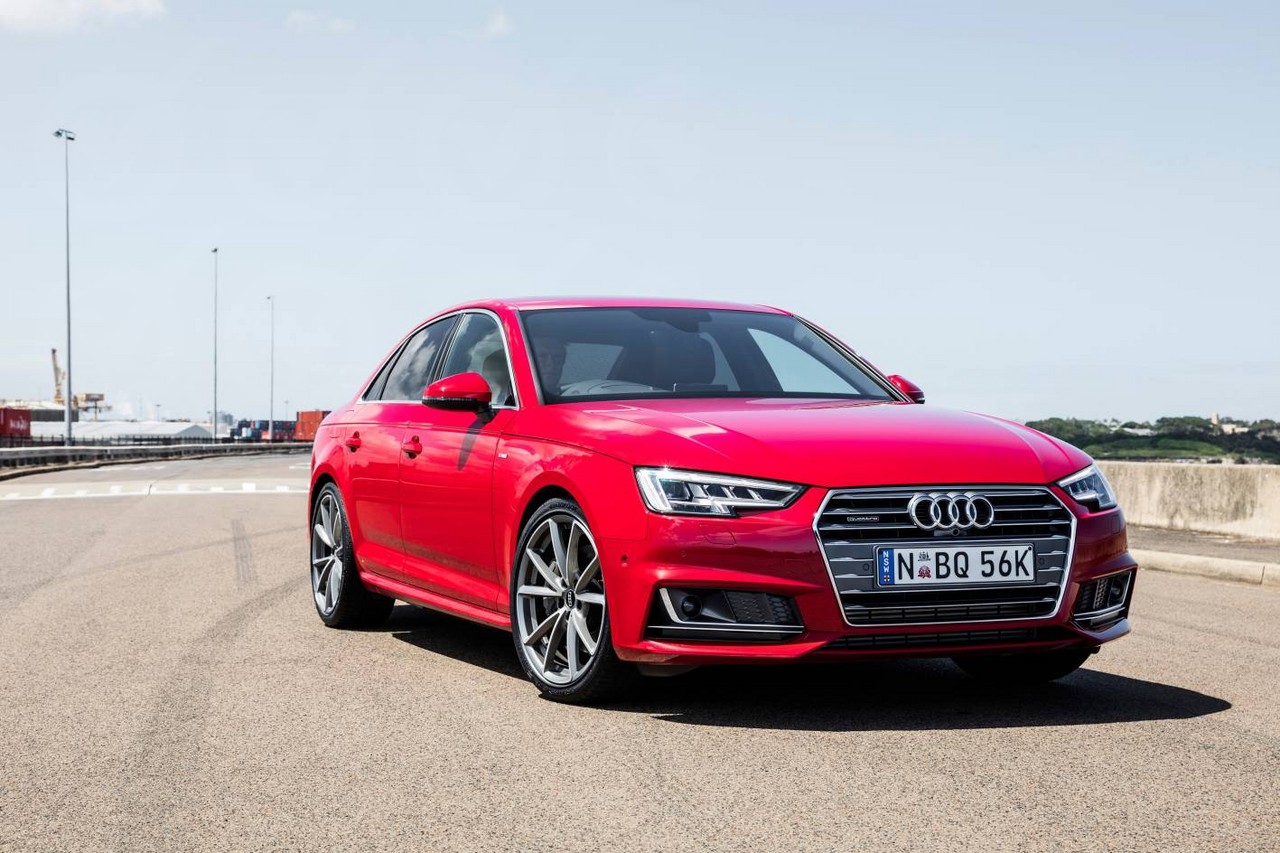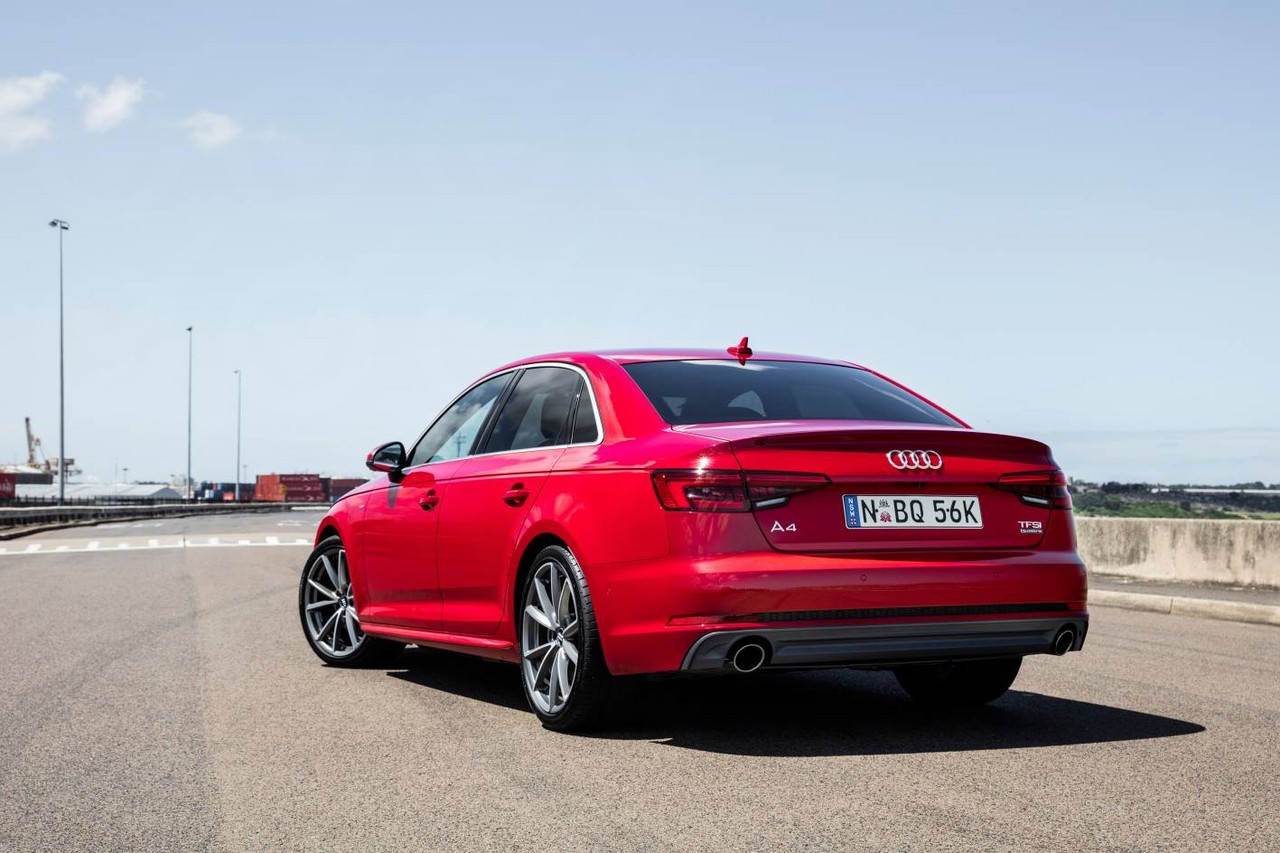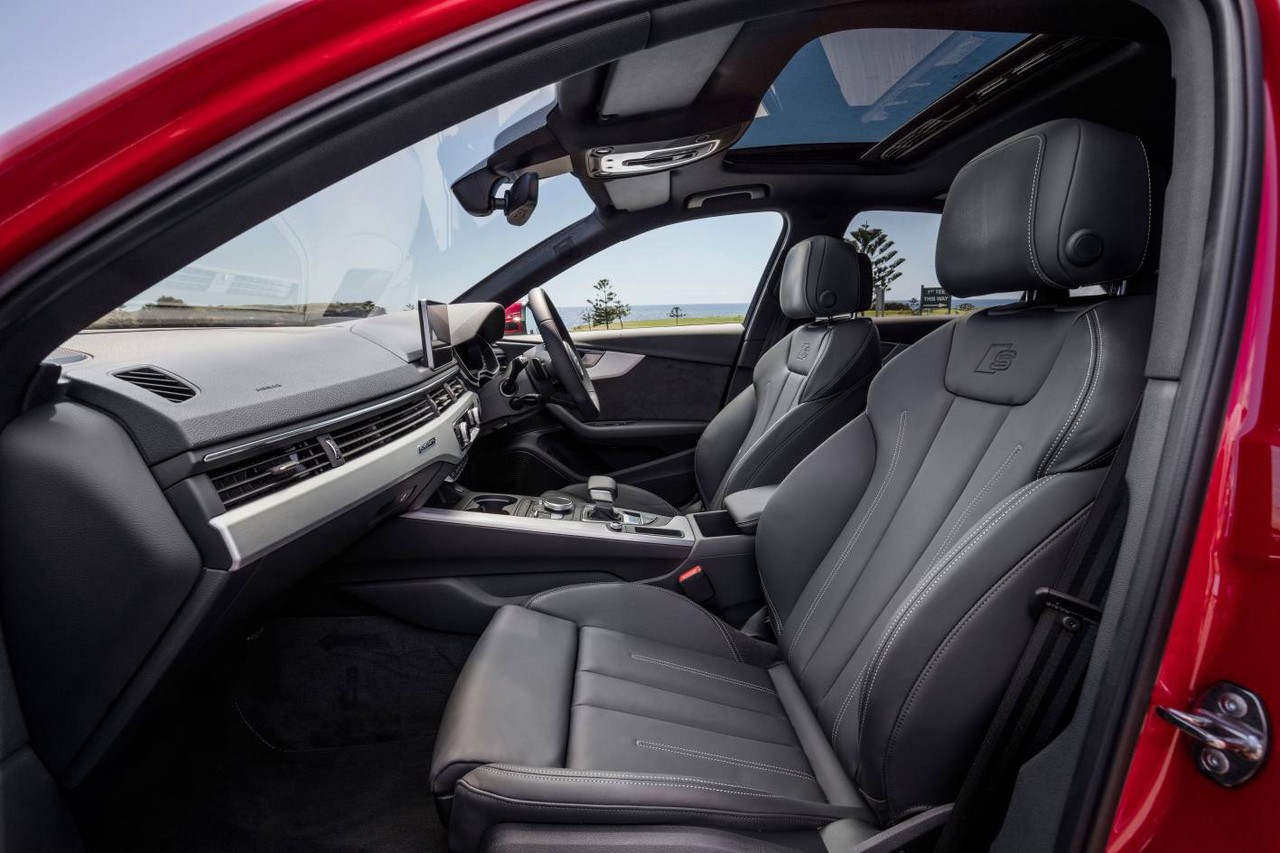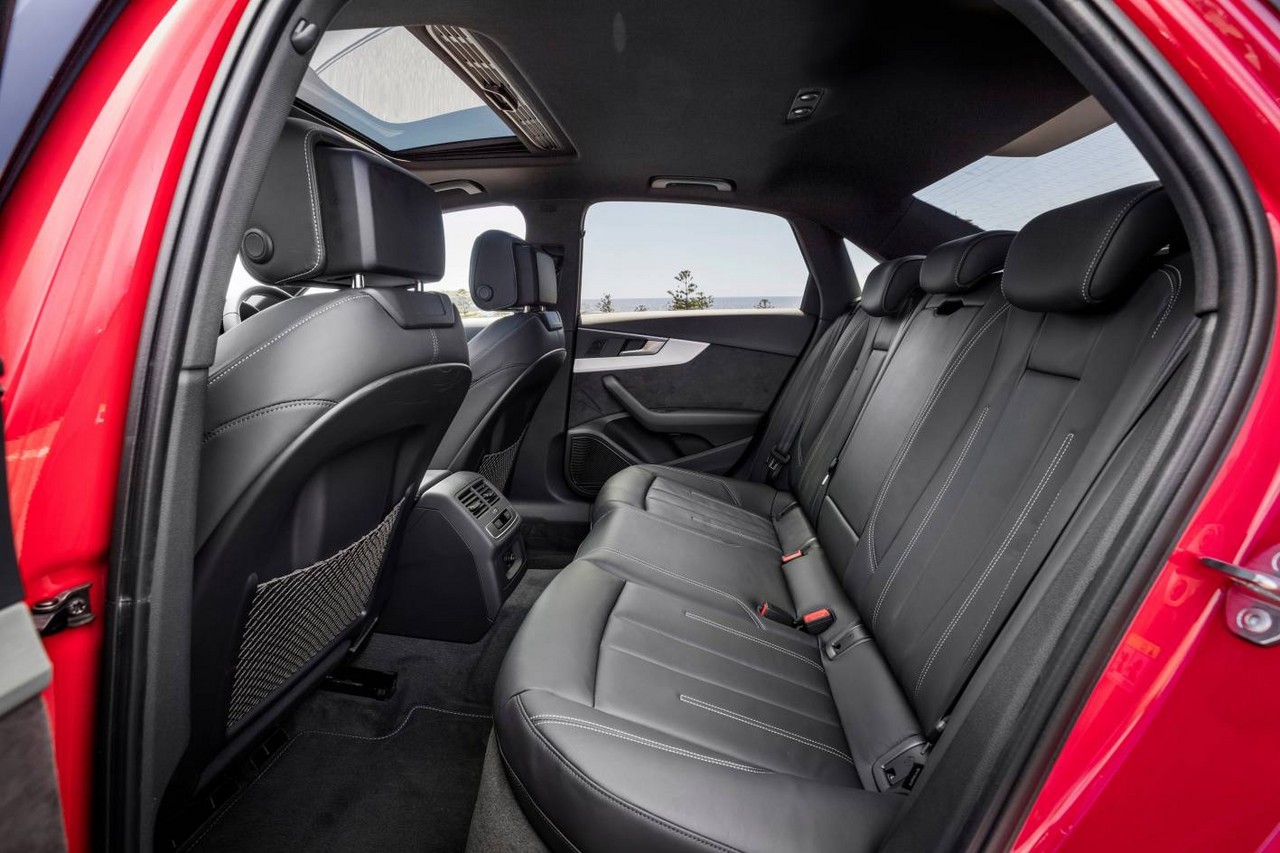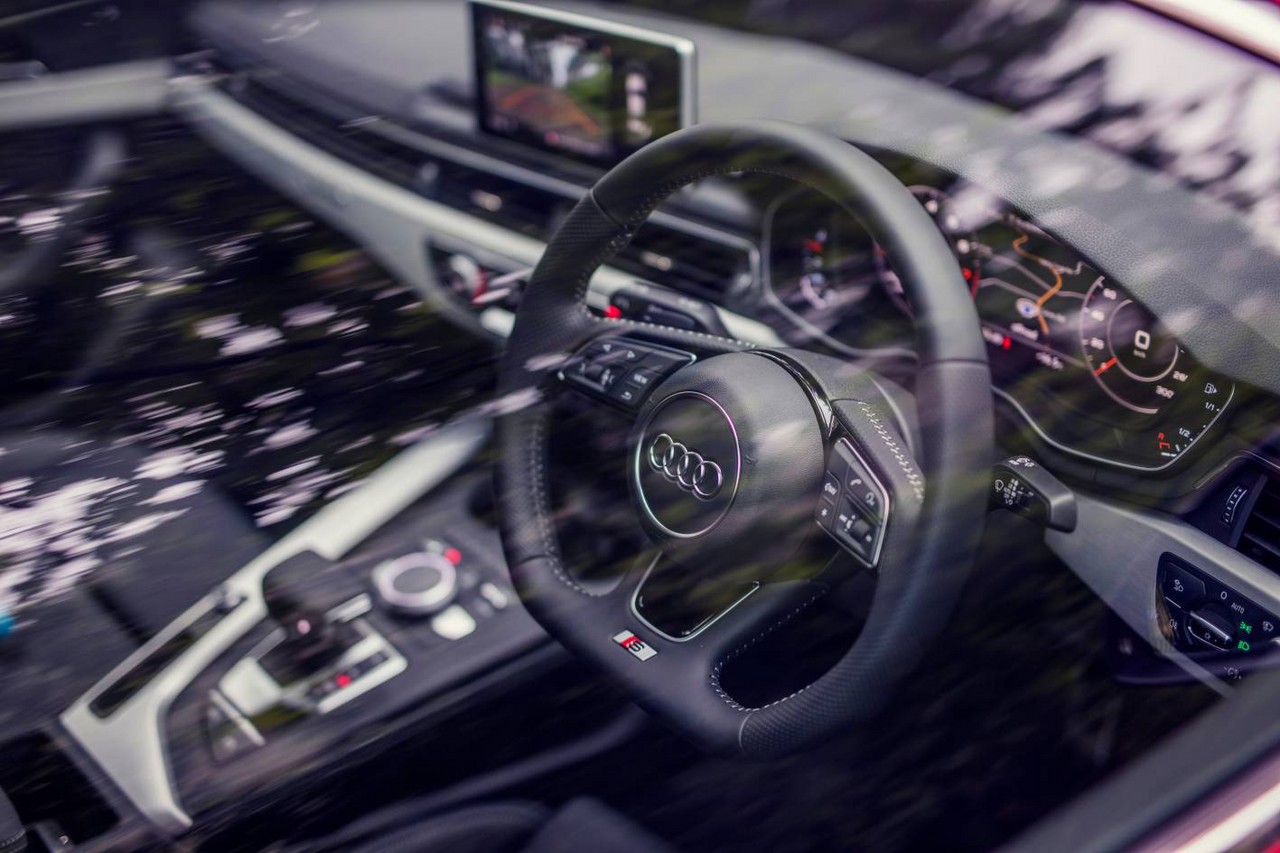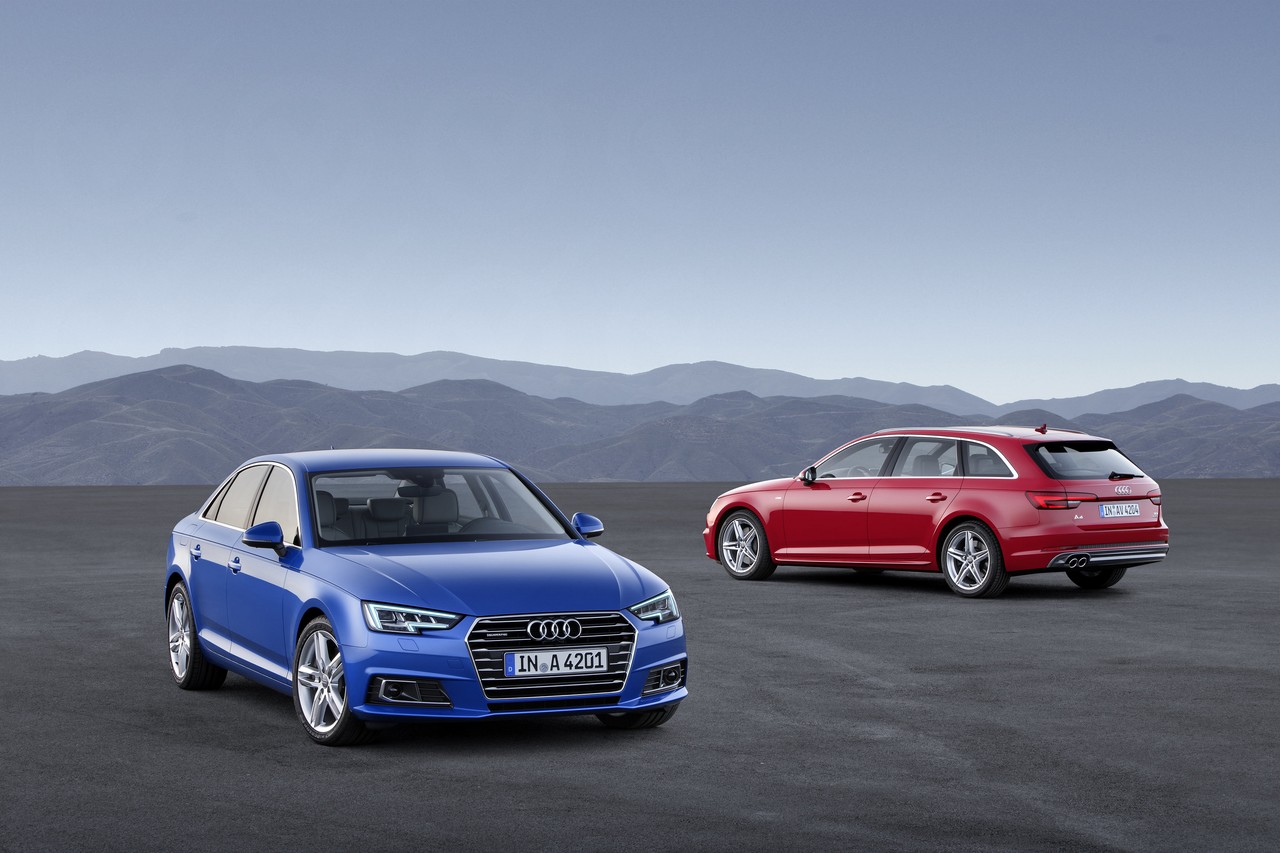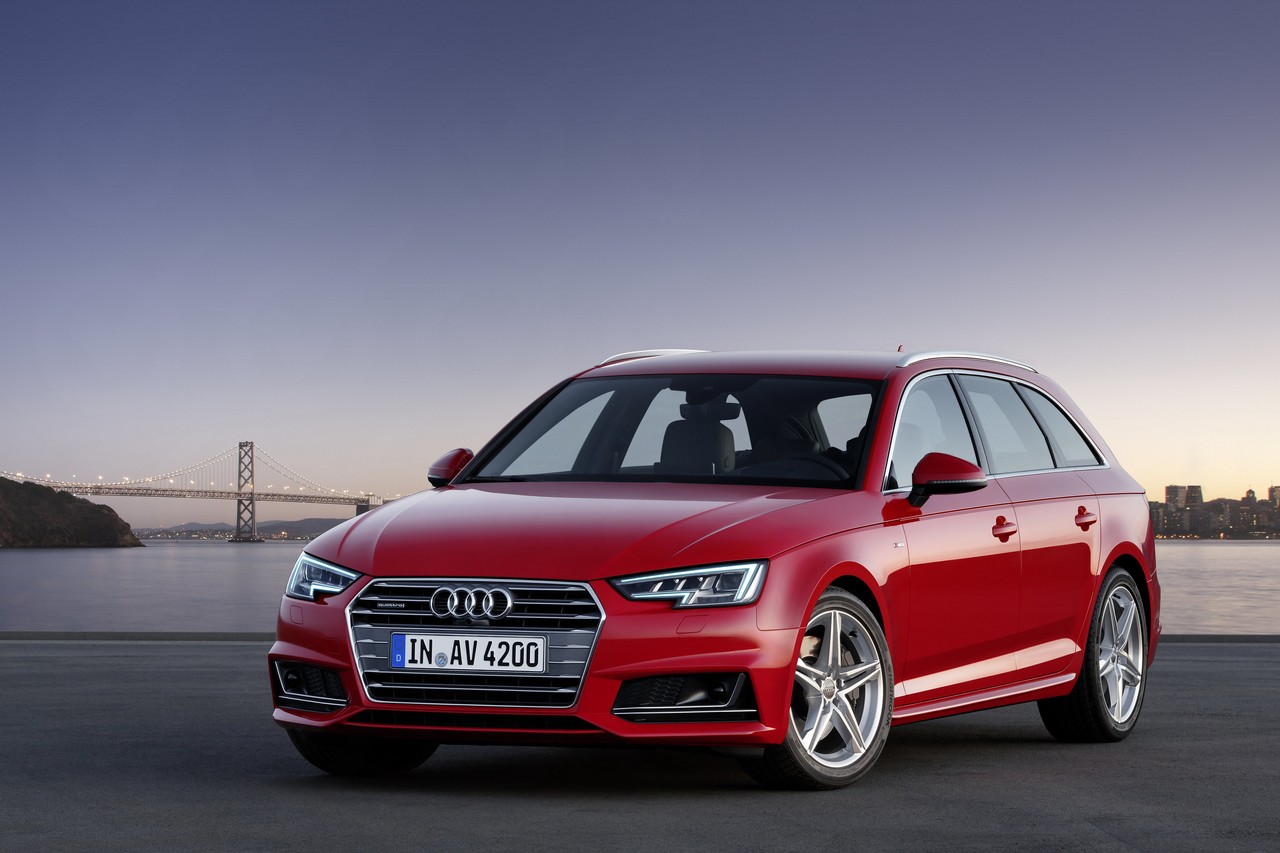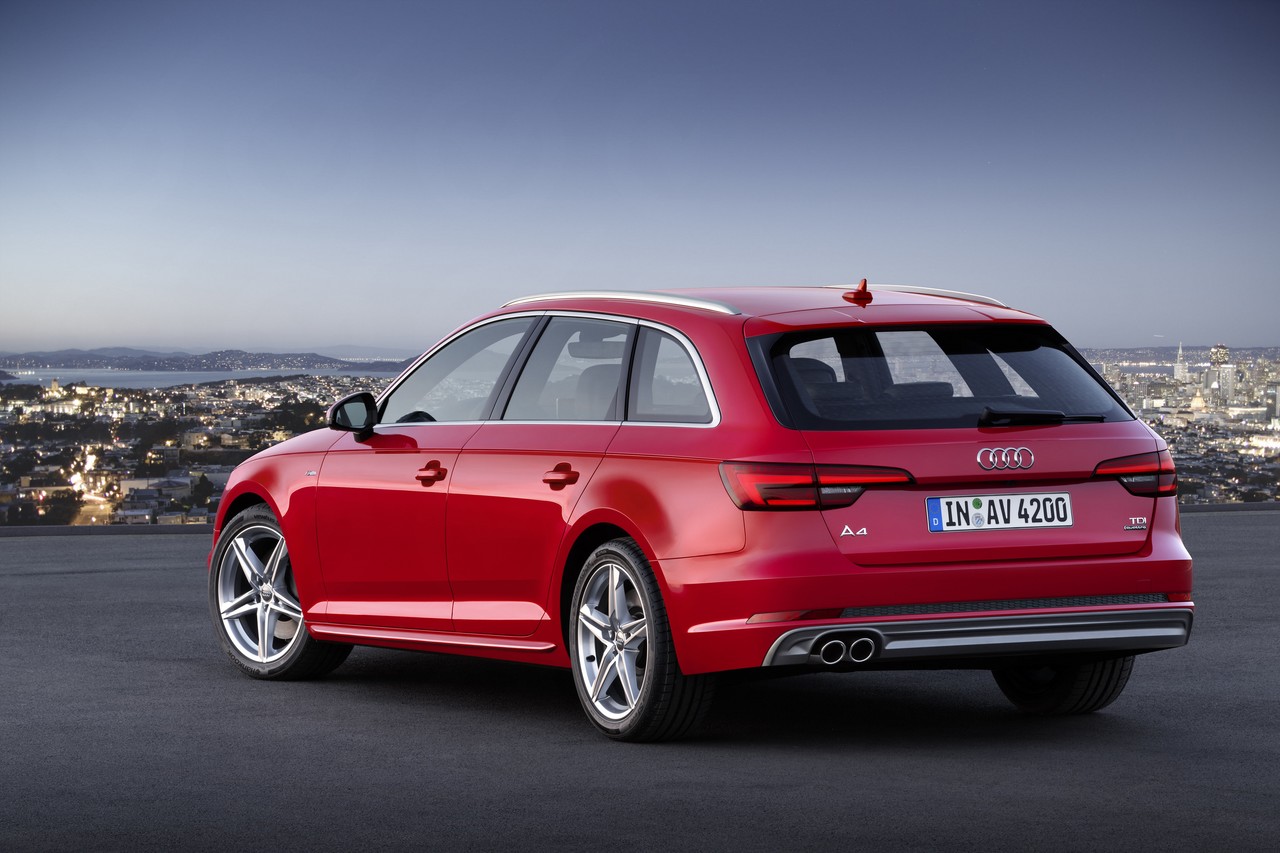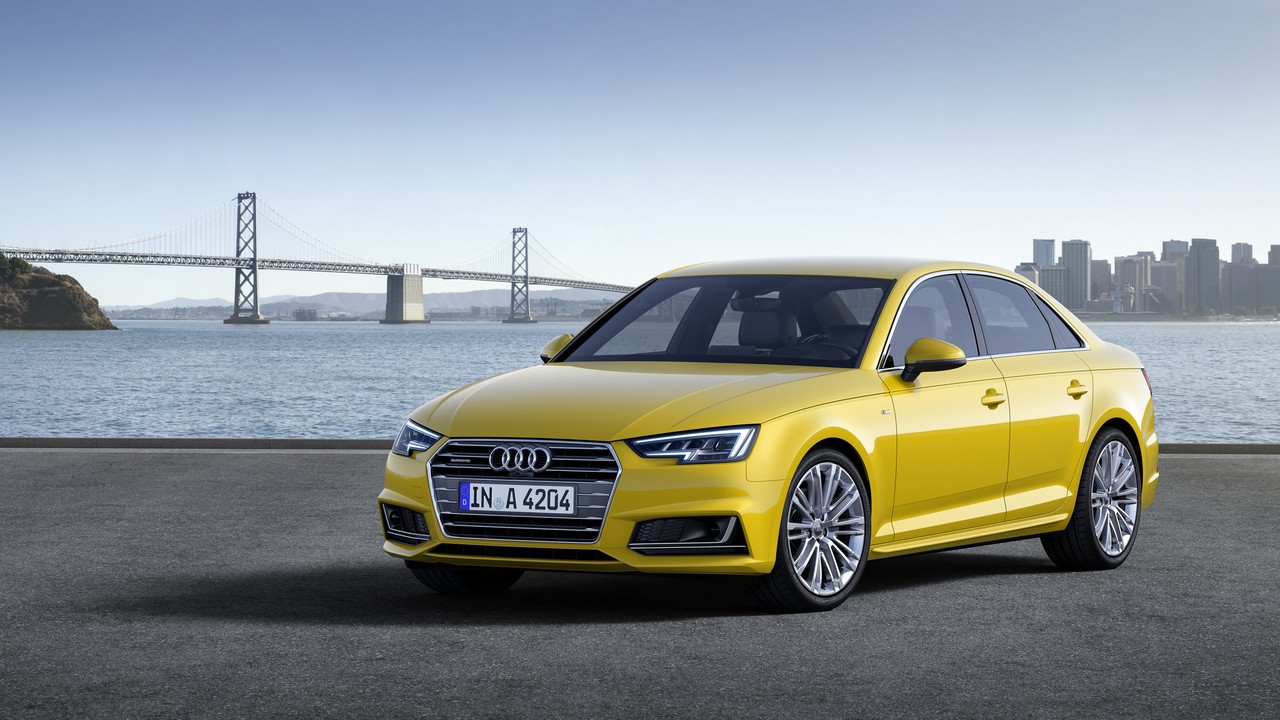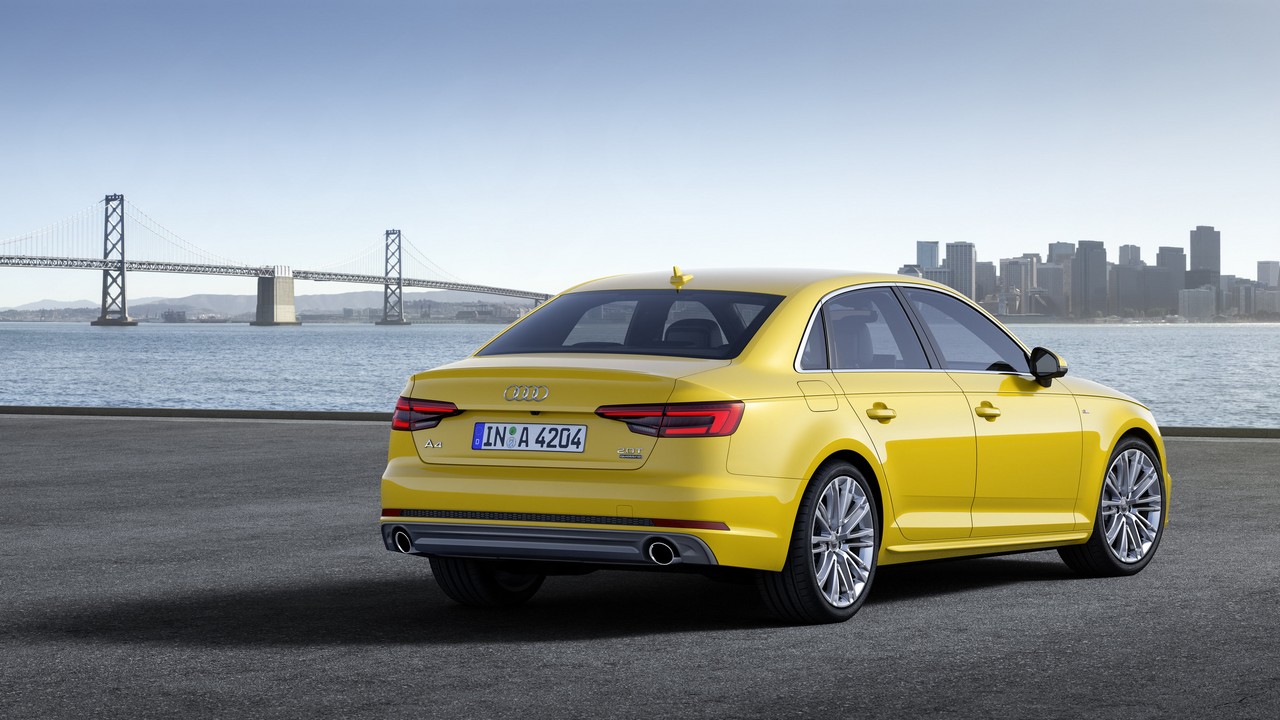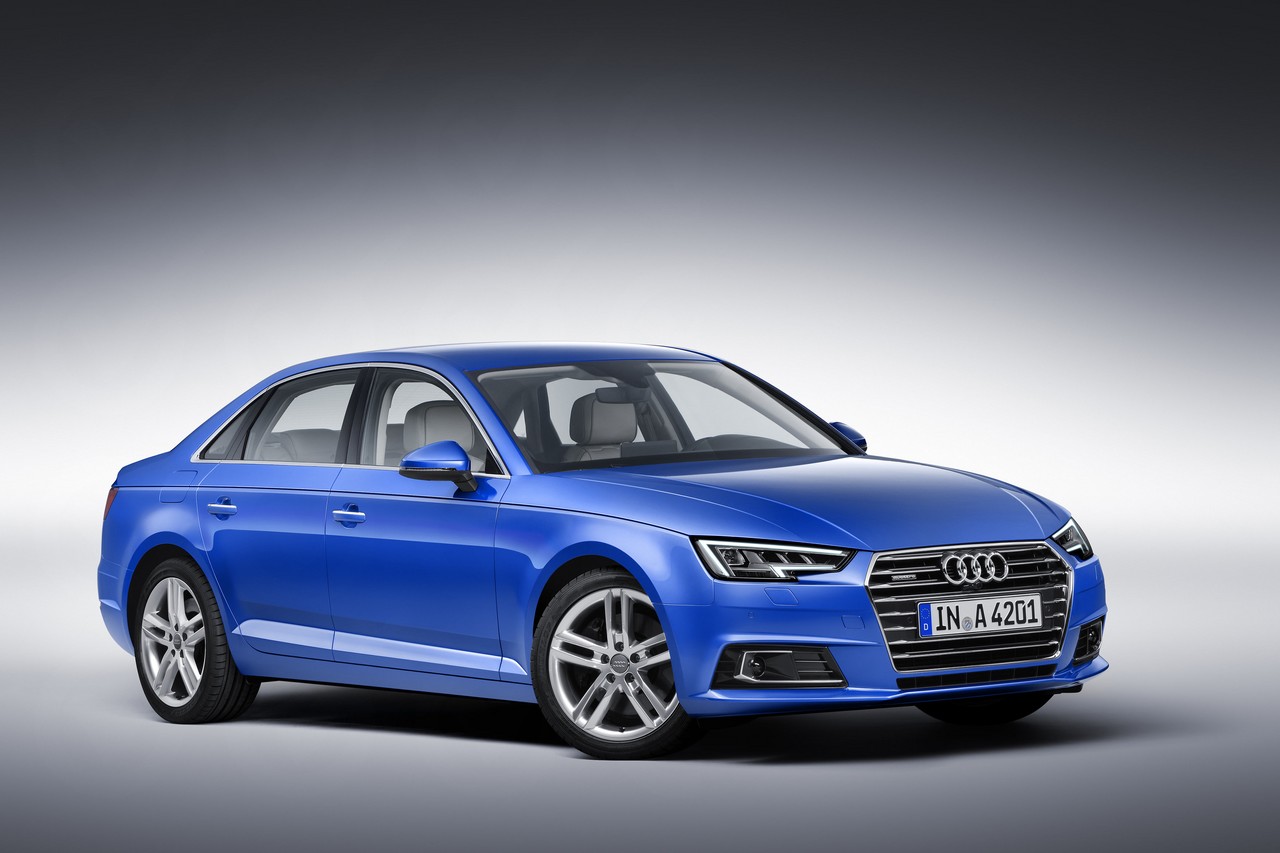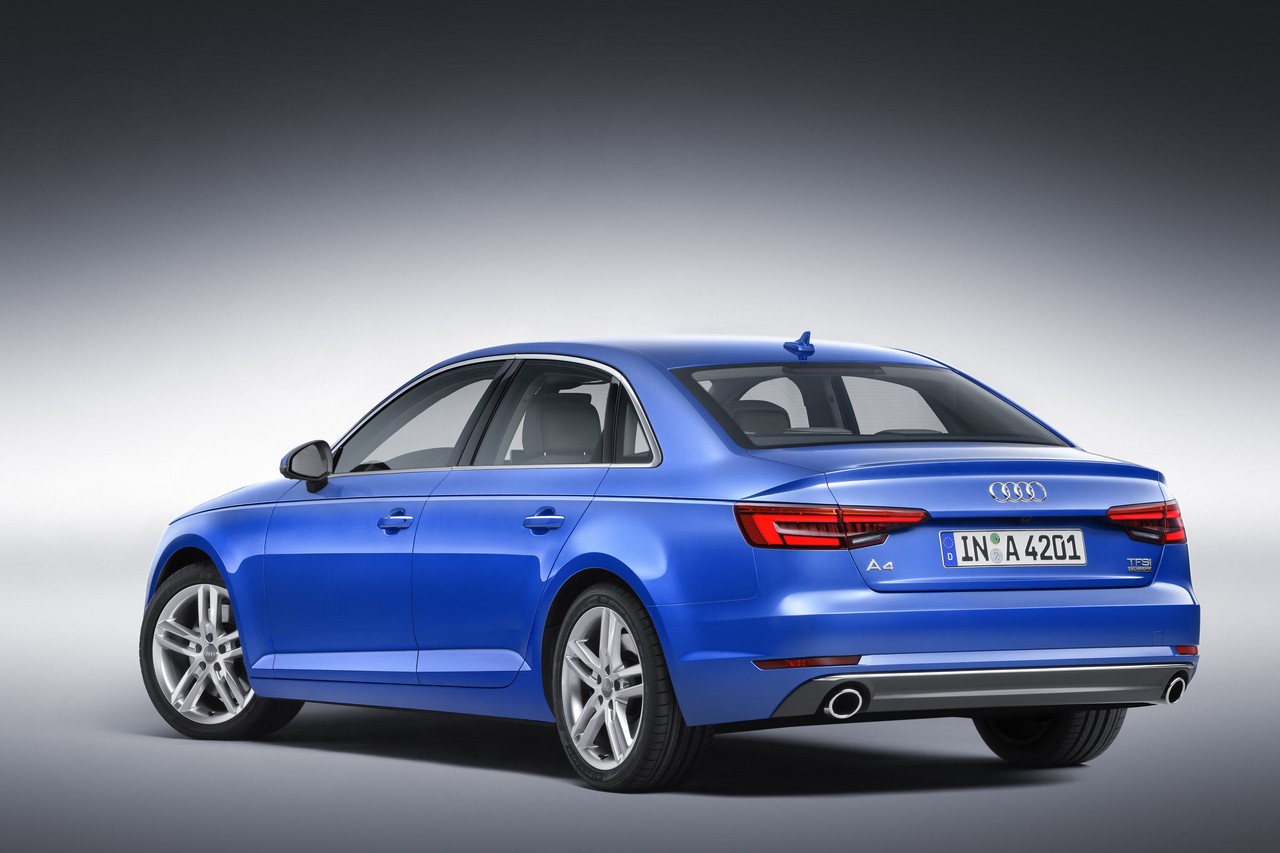
- Economical 1.4-litre turbo petrol engine
- Responsive 2.0-litre turbo petrol engine
- High standard of interior fit and finish
- Comfortable and supportive front seats
- Predictable handling
- Steering is overly assisted at low speeds and around centre, and lacks feedback
- Short-travel suspension lacks progressive damping and compliance
- On lower profile tyres, poor ride quality and increased interior noise
- S tronic transmission quick to upshift for fuel economy
- Limited rear seat headroom for A4 sedan
Overview
Commencing production in October 2015, the Audi B9 A4 and A4 Avant were compact executive sedans and wagons, respectively. Manufactured in Ingolstadt, Germany, the front- and four-wheel drive (‘quattro’) A4 and A4 Avant were available in 1.4 TFSI, 2.0 TFSI ultra, 2.0 TFSI and 2.0 TDI variants. For Australia, the B9 A4 was solely available with seven-speed double clutch transmissions (Audi’s ‘S-Tronic’).
To reduce fuel consumption,
- All engines for the Audi B9 A4 had a ‘Start-Stop’ function which enabled them to shut down as the vehicle is coming to rest – this occurs at speeds of 7 km/h and below, except for the 3.0 TDI with Tiptronic for which the threshold was 3 km/h;
- For models with double-clutch and automatic transmissions, a free-wheel function disengaged the engine from the driveline to reduce engine braking at speeds between 55 km/h and 160 km/h; and,
- For the ultra variants, modifications were made to the transmission ratios, bodywork and suspension, while low-resistance tyres were also fitted to further improve fuel economy.
| Variant | Engine | Trans. | Peak power | Peak torque |
|---|---|---|---|---|
| 1.4 TFSI | 1.4-litre turbo petrol I4 | 7sp DCT | 110 kW at 5000-6000 rpm | 250 Nm at 1500-3500 rpm |
| 2.0 TFSI ultra | 2.0-litre turbo petrol I4 | 7sp DCT | 140 kW at 4200-6000 rpm | 320 Nm at 1450-4200 rpm |
| 2.0 TFSI quattro | 2.0-litre turbo petrol I4 | 7sp DCT | 185 kW at 5000-6000 rpm | 370 Nm at 1600-4500 rpm |
| 2.0 TDI quattro | 2.0-litre turbo-diesel I4 | 7sp DCT | 140 kW at 3800-4200 rpm | 400 Nm at 1750-3000 rpm |
quattro
The four-wheel drive ‘quattro’ system for the B9 A4 was a purely mechanical system which utilised a self-locking central differential (designed as a planetary gear train). In normal conditions, the differential provides 60 per cent of the engine’s torque to the rear axle and 40 per cent to the front, i.e. a 40:60 front:rear torque split. Depending on the situation, however, up to 70 per cent of the engine’s torque could be transferred to the front and up to 85 per cent to the rear.
Wheel-selective torque control
As standard, the Audi B9 A4 had ‘wheel-selective torque control’. During ‘dynamic cornering’, wheel-selective torque control would brake the front inner wheel (for front-wheel drive models) or front and rear inside wheels (for quattro models) to prevent wheelspin and improve turn-in.
Body and dimensions
Compared to the Audi B8 A4 sedan , the B9 A4 sedan was 25 mm longer (at 4726 mm), 16 mm wider (1842 mm), the same height (1427 mm) and had a 12 mm longer wheelbase (2820 mm). Relative to the B9 A4 sedan, the B9 A4 Avant was 1 mm shorter (at 4725 mm) and 7 mm higher (1434 mm). According to Audi, the B9 A4 is up to 120 kg lighter than its B8 predecessor, depending on the engine.
To improve aerodynamics, the Audi B9 A4 TDI ultra variants had underbody panels and a frame behind the radiator grille which housed two blinds. The blinds were closed on start-up to reduce air resistance, but opened independently when air was needed to cool the engine. It is understood that the A4 TDI 2.0 ultra sedan has a drag coefficient of 0.23 Cd (the lowest in its class), while the A4 Avant 2.0 TDI ultra had a drag coefficient of 0.26 Cd.
The B9 A4 Avant had cargo capacity of 505 litres, with 1510 litres (to the roofline) available when the 40:20:40 split and folding rear seats were lowered. As standard, the A4 Avant had a power-operated luggage compartment cover and tailgate.
Suspension
The Audi B9 A4 had five link front suspension in which the upper links were integrated into the bodywork and the lower links were attached with rubber mounts to a hybrid steel/aluminium sub-frame. For the five-link rear suspension, the axle was insulated from the body by hydraulically damped axle mounts. To reduce mass, the axle links, pivot bearings and dampers stilts were made of forged aluminium.
While the standard suspension for the Audi B9 A4 used monotube dampers, A4 variants with engines producing 140 kW and above had ‘Continuous Damping Control’ (CDC) shock absorbers which featured electromagnetically controlled valves in their pistons to control the flow of hydraulic fluid. For the CDC system, the central suspension control unit processed inputs from sensors that measured movement and acceleration (longitudinal and transverse) to control each shock absorbed individually. Furthermore, the ‘Audi drive select driving-dynamics’ system enabled the driver to select from ‘sports’ or ‘comfort’ settings. Compared to the A4 with standard monotube shock absorbers, the body of the A4 with variable shock absorbers was 10 mm lower in the comfort setting and 23 mm lower in the sport setting.
Steering
The Audi B9 A4 had electromechanical power steering with a ratio of 15.9:1 in which the level of power assistance was inversely proportional to vehicle speed. As an option, the B9 A4 was available with ‘dynamic steering’ which varied its ratio – by up to 100 per cent – according to the vehicle’s speed, steering angle and the mode selected in the ‘Audi drive select driving-dynamics’ system.
Safety equipment
Standard safety equipment for the Audi B9 A4 included dual front airbags, front and rear side airbags, full-length curtain airbags (i.e. for front and rear occupants), ABS, electronic brake force distribution, brake assist, electronic stability control, traction control and front seatbelts with pre-tensioners and load limiters.
As standard, the B9 A4 was also fitted with:
- Audi pre sense city: operating at speeds up to 85 km/h, Audi pre sense city used a windscreen-mounted front camera to scan the road for other vehicles and pedestrians. If there was a risk of a collision, the driver received a series of warnings. If the driver fails to respond, full braking force could be applied autonomously. At initial speeds of up to 40 km/h, collisions could be prevented; at higher speeds (up to 85 km/h), the severity of the collision would be reduced;
- Multi-collision brake: in the event of a collision, the multi-collision brake system provided ‘controlled application of the brakes’ to prevent the car from skidding and to prevent further collisions; and,
- Attention assist: monitored driver behaviour and issued a warning if the driver was assessed to be ‘inattentive’.
As standard, the Australian-delivered Audi A4 was also equipped with:
- Audi pre sense basic: initiated occupant protection measures such as tightening the front seatbelts, closing the windows and sunroof (where fitted), and activating the hazard lights when ‘unstable driving conditions’ were detected;
- Audi pre sense rear: could warn of potential collisions from behind, warn following traffic by rapidly flashing the brake lights and activate the ‘Audi pre sense basic’ protection measures described above;
- Audi side assist: operated at speeds above 15 km/h, Audi side assist used the two rear radar sensors to monitor traffic up to 70 metres behind the A4. If another vehicle approached quickly or was in the driver’s blind spot, a warning LED in the housing of the appropriate door mirror would illuminate. If the driver activated the indicator to change lanes, the LED would blink rapidly to warn the driver;
- Rear cross-traffic assist: when reversing at low speeds, rear cross-traffic assist used the rear radar sensors to detect approaching traffic. If approaching traffic was detected which may cross the vehicle’s path, the driver would receive warnings (visual, acoustic and a brief, jolting application of the brakes); and,
- Exit warning: activated when the vehicle stops moving and could warn occupants if vehicles were approaching from behind by illuminating red fibre optics in the door-opening mechanism as the doors were opened.
Available as an extra-cost option, ‘Audi pre sense front’ system could prevent front-to-rear collisions or reduce their severity. In hazardous situations, the driver would receive warnings visual and acoustic warnings to apply the brakes, followed by a brief application of the brakes for a jolting effect to alert the driver. If the driver fails to respond, the A4 would decelerate to the greatest possible extent if the vehicle ahead of it is still moving.
Assistance Package Tour
As an extra-cost option, the Audi B9 A4 was available with ‘Assistance Package Tour’ which included the following technologies: :
- Adaptive Cruise Control (ACC): using two front radar sensors and the camera, ACC can maintain a specified distance – from five distances – between the A4 and the vehicle ahead. Furthermore, ‘Audi drive select’ can be used to adjust the rate of acceleration and other control dynamics;
- Stop&Go function: an extension of the ACC and limited to models with automatic transmissions, ‘Stop&Go’ operated at speeds of 60 km/h to apply the brakes and bring the vehicle to rest. Once traffic began moving, the Audi A4 will automatically accelerate;
- Traffic-jam assist: an extension of the ACC, traffic-jam assist function can take control of steering operations at speeds up to 65 km/h on ‘well-developed roads when traffic is congested.’ In doing so, traffic-jam assist uses the lane markings and other vehicles on the road for orientation. When the traffic-jam assist function reaches its limits – for example, when traffic is sparse or there is a sharp corner ahead – the driver has to take over steering. Hence, the system provides warnings at different levels;
- Avoidance assist: activated when the A4 needed to avoid an obstacle to avert a collision. Using data from the front camera, the ACC and radar sensors, ‘avoidance assist’ could calculate the distance of the car ahead, its width and degree of offset. The brakes would be briefly applied to alert the driver of the potential danger and, once the driver started steering, the system would provide ‘support with the necessary lane changes with controlled interventions to the power steering’;
- Turning assist: active at speeds from 2 km/h to 10 km/h, ‘Turning assist’ can monitor oncoming traffic during right turns (for cars with right-hand drive). In hazardous situations, the brakes can be applied to bring the vehicle to rest. Turning assist operates once the driver activates the right-hand turn signal; and,
- Audi active lane assist (also available separately): used the front camera to detect lane markings at speeds of 65 km/h and above. If the Audi A4 approached a lane marking without the driver having previously indicated, the electromechanical steering could provide an adjustment to bring the vehicle back into its lane. Using the MMI system, the driver could determine whether this system should be activated at all times or only before the lane marking is crossed. As an option, the driver could choose to have steering wheel vibrations as a warning signal.
Euro NCAP testing
In Euro NCAP testing , the Audi B9 A4 received a five star safety rating which included an 89 per cent adult occupant protection rating, an 87 per cent child occupant protection rating and a 75 per cent ‘safety assist’ rating. In the frontal offset test, protection of the driver’s head, thighs and feet were rated as good, though lower leg protection was rated as adequate (a slight risk of serious injury) and chest protection as marginal (a moderate risk of serious injury). Maximum points were awarded in the side impact test; in the more severe pole test, however, chest protection was rated as marginal.
Features: Audi A4 1.4 TFSI
Standard features for the Audi A4 1.4 TFSI included 18-inch ten-spoke alloy wheels, an eight speaker sound system with CD/DVD player, two SDXC card readers and 10 GB memory, Audi music interface via USB including Audi smartphone interface, Bluetooth mobile phone connectivity and audio streaming, ‘MMI navigation plus’ system with an 8.3-inch high resolution colour display, live traffic updates and voice control, ‘Audi connect’ in-car WiFi hotspot (required data plan), leather-appointed trim, front sports seats, a power adjustable driver’s seat, three-zone climate control air conditioning, cruise control with braking, LED headlights, LED daytime driving lights, dusk-sensing headlights, rain-sensing wipers, leather steering wheel with gearshift paddles, remote central locking, power adjustable and heated door mirrors, power mirrors, tilt and telescopic steering wheel adjustment, ambient lighting, tyre pressure monitoring, a trip computer and an immobiliser.
As standard, the A4 1.4 TFSI was also equipped with the ‘Audi parking system plus’ which included a rear view camera and parking sensors (front and rear). Across the Audi A4 range, a space saver spare wheel was fitted as standard.
Features: Audi A4 2.0 TFSI
Compared to the A4 1.4 TFSI, the A4 2.0 TFSI was further equipped with 18-inch five-twin-spoke alloy wheels, digital radio tuner (DAB), proximity key (i.e. keyless entry), a power adjustable front passenger seat, push-button start and an auto-dimming rear view mirror.
Features: Audi A4 2.0 TDI quattro and 2.0 TFSI quattro
The Audi A4 2.0 TDI quattro and 2.0 TFSI quattro were distinguished by their 19-inch ‘Audi Sport’ alloy wheels, 180 watt sound system with ten speakers (including centre speaker and subwoofer) and a six-channel amplifier, power folding door mirrors with passenger side kerb view on reverse, and driver memory settings for the seat and door mirror positions.
S line Sport Package
As an option, the Audi B9 A4 was available with an ‘S line’ Sport Package which featured a black or ‘rotor gray’ interior. Furthermore, the sport seats were upholstered with:
- A combination of pearl nappa leather and sequence cloth;
- Pearl nappa leather with embossed frequency Alcantara; or,
- Fine nappa leather.
Other elements for the S line sport package included brushed aluminium or piano black lacquer inlays, ‘S’ emblems for the sport steering wheel and illuminated door-sill trims, stainless steel pedals and footrests, and floor mats with contrasting stitching.
Parking Assistance Package
As an option, the Audi A4 was available with a ‘Parking Assistance Package’ which included:
- Park assist: used twelve radar sensors to identify and control the steering wheel to manoeuvre the vehicle into – or out of – parallel or right angle parking spaces; and,
- 360 degree cameras which enabled a virtual 360 degree view or 180 degree front/rear views to be displayed on the MMI monitor.
Specifications
Related links
